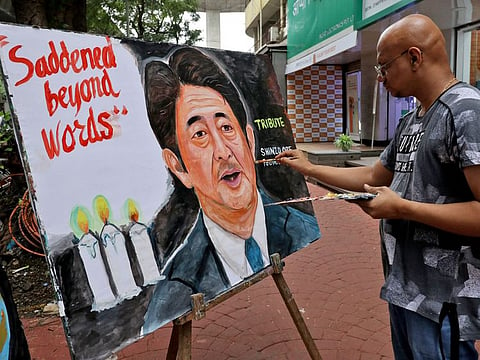Shinzo Abe: India’s friend in Japan
Former Japanese prime minister worked tirelessly to advance India-Japan ties

Japan’s former prime minister Shinzo Abe is being mourned in India. As a great friend of the country, Abe steered Japan towards a much closer relationship with India, starting with Manmohan Singh and then during the tenure of Prime Minister Narendra Modi.
In January 2014, Abe became the first Japanese prime minister to be the chief guest at India’s Republic Day celebrations. Later that year, Modi would win landslide elections, continuing and strengthening the India-Japan relationship. Modi described Abe as one of his “dearest friends” on Friday while announcing a day of national mourning for the Japanese leader, who was assassinated on July 8, 2022. Former India prime minister Manmohan Singh wrote a condolence letter to Japan’s ambassador, describing Abe as “a good friend of mine. During my tenure as prime minister, we worked to raise our ties to the level of a global and strategic partnership”.
As Japan’s longest-serving prime minister, Abe invested heavily in the relationship with India. In 2021, India conferred on him one of its highest civilian awards, the Padma Vibhushan.
India always had a special place in his [Abe’s] heart. In 2006, he wrote that India was a “beautiful country” and that in 10 years, Japan-India relations could overtake Japan-US ties.
During Abe’s first stint as prime minister (2006-2007), he visited New Delhi, making a speech in the Indian parliament about the “Confluence of Two Seas”, which eventually led to the Indo-Pacific strategic framework. He pushed India and Japan to go beyond trade ties and look at a strategic partnership. In the years to come, this would bear fruit with India and Japan upgrading ties to establish a strategic and global partnership during Manmohan Singh’s time.
Abe visited India three times during his second term (2012-2020) — the most number of visits by a Japanese prime minister to India. He convinced anti-nuclear hawks back home to sign a nuclear deal with India in 2016, and India-Japan ties soared, resulting in partnerships in maritime security and bullet trains as well as a confluence in the Indo- Pacific. Defence ties too were cemented with an agreement in 2015 to transfer equipment and technology.
He also played a key role in reviving the quad — the alliance of India, the US, Australia and Japan — to take on China. The grouping was revived in late 2017 thanks to Abe’s efforts to bring like-minded democracies together. Quad’s statement on Abe’s death called him “a transformative leader for Japan and Japanese relations with each one of our countries. He played a formative role in founding the quad partnership and worked tirelessly to advance a shared vision for a free and open Indo-Pacific”.
Indeed, Abe’s tenure as prime minister was marked by concerted efforts to take on China’s growing clout and strengthen Japan economically and militarily. This included boosting Japan’s defence spending. He also pushed through laws to let Japan exercise the right of “collective self-defence” or militarily aiding an ally under attack.
Abe hailed from a wealthy political family. His grandfather, the late prime minister Nobusuke Kishi, was a key influence. Kishi tried unsuccessfully to revise Japan’s US-drafted 1947 constitution to become an equal security partner with the United States and adopt more assertive diplomacy — issues central to Abe’s agenda.
A divisive figure for many, one of Abe’s central goals was to revise Japan’s pacifist constitution, which paved the way for the country’s post-war record of peace.
In 2020, Abe stepped down as prime minister, citing ill health but continued to work for closer India-Japan ties. India always had a special place in his heart. In 2006, he wrote that India was a “beautiful country” and that in 10 years, Japan-India relations could overtake Japan-US ties.
The India-Japan relationship has come a long way. That is largely due to Abe.
Sign up for the Daily Briefing
Get the latest news and updates straight to your inbox








